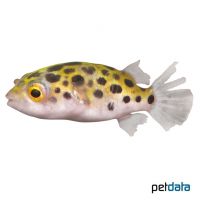Green Spotted Puffer (Dichotomyctere nigroviridis)
| Green Spotted Puffer Dichotomyctere nigroviridis | |
|---|---|
| Name | Green Spotted Puffer |
| Name Lat. | Dichotomyctere nigroviridis |
| Synonym | Tetraodon nigroviridis |
| Family | Puffers |
| Family lat. | Tetraodontidae |
| Order | Puffers & Filefishes |
| Order lat. | Tetraodontiformes |
| Origin | South, Southeast Asia |
| Habitat | Estuaries, brackish water |
| Diet | Carnivore |
| pH | 7.5-8.5 |
| Behavior | Semi-aggressive |
| Keeping | Individual, group |
| Care Level | Difficult |
| Reproduction | Substrate spawner |
| Breeding | Difficult |
| Life Span | 8-12 years |
| Protection | No |
| Metric Units | |
| Size | 17 cm |
| Temperature | 24-28 °C |
| Hardness | 10-20 °dH |
| Aquarium | ~ 350 l |
| US Units | |
| Size | 6.7" |
| Temperature | 75-82 °F |
| Hardness | 178-356 ppm |
| Aquarium | ~ 90 gal |
Distribution and habitat
Green-spotted pufferfishes are widely distributed in nearshore waters from Sri Lanka to India to the Philippines and south to Indonesia. They live in various biotopes, such as streams, rivers and ponds, as well as in the brackish water of mangrove swamps and estuaries.
Maintenance
The aquarium should have a dense planting, with many hiding places (stones, roots) and provide sufficient swimming space. A dark, fine sandy substrate covered with some foliage (e.g. sea almond leaves), shaded light (floating plants) and brackish water with a weak current is ideal. No ammonia, ammonium and nitrite should be detectable, the nitrate value should not exceed 100 mg/l. To ensure the water quality and oxygen content, a filter and heater adapted to the aquarium size is required, as well as lighting for the species-appropriate day-night rhythm of the animals.
Diet
They are food specialists that eat almost exclusively crustaceans. The food supply consists of snails (e.g. bubble snails, or apple snails) supplemented with live or frozen food, such as shrimp, mosquito larvae, artemia, mysis, etc., as well as mussel and crab meat or a frozen special food mixture. Rarely dry food is accepted
It is recommended to feed small portions several times a day, which are eaten within a few minutes. A regular and varied diet promotes health and increases resistance.
Behaviour and compatibility
It is recommended to keep them individually or in a group of at least 4 fish. For group keeping a larger, richly structured tank is recommended. Within the species they behave very territorial and are often also incompatible and biting towards other fish. They are considered fin twitchers that should not be kept with long-finned fish and are only conditionally suitable for a community tank
Basically, only compatible fish species with similar demands on water condition and water temperature should be socialized.
Sex dimorphism
No reliable sex differentiation is known. The males are slightly larger than the rounder females.
Reproduction and breeding
Green spotted pufferfish are substrate spawners. When a harmonizing pair is found, the female spawns on a flat rock or other substrate. The male intensively defends the clutch. After about 7 days the young swim free. Breeding is only successful in brackish water. Young fish must be fed several times a day with special rearing food. In community tanks breeding is hardly possible, because the spawn is an easy prey
Important
Permanent keeping is possible only in brackish water (10-30 ‰ salinity)
They need the hard shells of snails, or the shells of shrimps, crabs and crayfish to wear their teeth, which are constantly growing back. When threatened, they can inflate to 2-3 times their size by filling their elastic stomach with air or water. The flesh of the green puffer fish contains tetrodotoxin, a neurotoxin that is deadly to humans and animals.
A cup filled with aquarium water, not a trap net, should be used for transferring or transferring the animals so that they do not become airborne.
The well-being of the fish should be checked regularly. Temperature should be checked daily, pH, hardness and nitrate levels at least every 14 days. Regular partial water changes are recommended, even if the contaminant level has not yet reached the upper limit. Sudden changes in water quality should be avoided. Newly introduced fish must be accustomed slowly to the water in the aquarium.
Further literature can be found in your pet store.
References
Text: Werner Winter; Image: petdata
Source: BMEL (1998): Tierschutzgutachten - Haltung von Zierfischen (Süßwasser); RIEHL & BAENSCH (2006): Aquarien Atlas Bd. 1, Mergus Verlag; ENGELMANN (2005): Zootierhaltung - Tiere in menschlicher Obhut: Fische, Verlag Harri Deutsch
- Gemäß § 21 Abs. 5 Tierschutzgesetz idgF
